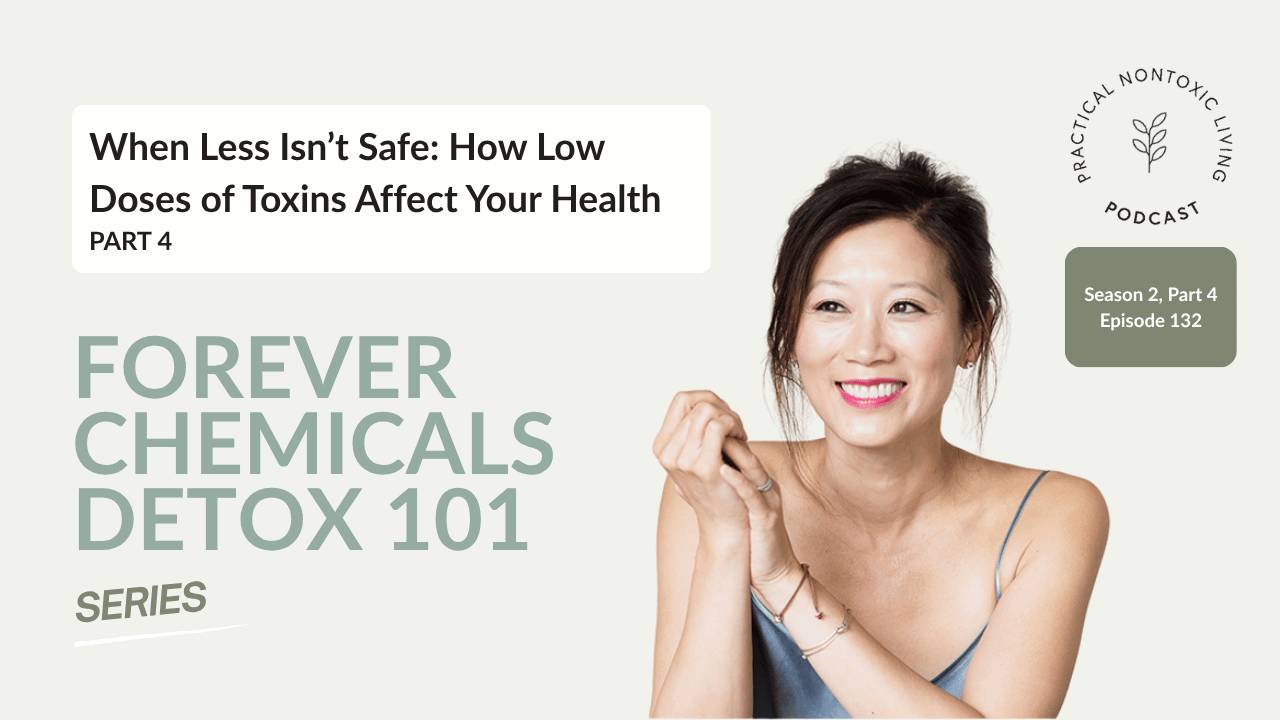
When Less Isn’t Safe: How Low Doses of Toxins Affect Your Health
Oct 10, 2025Part 4 of Season 2: Forever Chemicals Detox 101
We’ve all heard the old saying: “The dose makes the poison.”
For decades, that phrase shaped how we thought about safety—the assumption being that small exposures can’t hurt you.
But modern science paints a different picture. Even extremely low levels of common chemicals—like PFAS, endocrine disruptors, and heavy metals—can affect your health in powerful ways.
In Episode 132 of the Practical Nontoxic Living™ podcast, Sophia Ruan Gushée explores what new research reveals about low-dose toxicity: how tiny exposures can have big effects, why when you’re exposed matters as much as how much, and what simple steps you can take at home to reduce your risks and build resilience.
Rethinking “The Dose Makes the Poison”
For decades, toxicology operated under a comforting idea: the higher the dose, the greater the risk. Small doses were assumed safe.
But the Endocrine Society—the world’s leading scientific authority on hormones—now warns otherwise:
“EDCs do not behave like other chemicals, and current regulatory practices do not account for the ways that EDCs can pose health threats. EDC exposures at even extremely low dosages can alter biological outcomes, and the effects of low doses cannot be predicted by the effects observed at high doses. This means there may be no safe dose for exposure to EDCs.”
This means that exposures once considered trivial can actually disrupt the delicate hormonal systems that regulate development, metabolism, fertility, and immune function.
The “Cocktail Effect” of Everyday Exposures
In real life, we’re never exposed to one chemical at a time.
Each day, we encounter hundreds—from cleaning products and food packaging to water contaminants and household dust. Scientists call this the “cocktail effect.” Studies show that combinations of chemicals can amplify harm:
-
PCBs and mercury together cause more damage than either chemical alone, effecting things like the cardiovascular system and dopamine levels
-
Arsenic and estrogen, at individually “safe” levels, nearly doubled cancer risk in lab studies.
Because these interactions are complex and poorly studied, researchers can’t always predict how they’ll affect health. The takeaway? Reducing exposures where you can makes a real difference.
Why Timing Matters
Certain stages of life—pregnancy, infancy, puberty, and menopause—are particularly vulnerable to endocrine disruption. During these critical windows, hormones act as messengers guiding growth and organ formation. When synthetic chemicals interfere, they can send false signals that alter development or increase disease risk years later.
For example, research has shown that women exposed to DDT before puberty were five times more likely to develop breast cancer later in life than those exposed afterward. The same principle applies to modern endocrine disruptors: timing is everything.
Complexity and Cumulative Effects
Traditional toxicology often studies one chemical at a time. But in the real world, we face repeated low-dose exposures to many different compounds—daily, over years. These exposures can:
-
Accumulate in the body.
-
Interact to create new, unpredictable effects.
-
Potentiate other chemicals, making us more sensitive to harm.
- Increase your body burden and effect offspring
That’s why the absence of proof of harm should never be mistaken for proof of safety. As Sophia explains in A to Z of D-Toxing, “Lack of proof of harm should not be assumed to be proof of safety.”
From Overwhelm to Empowerment
This information can sound daunting—but it’s actually empowering.
If small doses can harm, then small changes can help. Here are three simple ways to start protecting your home and health today:
-
Avoid nonstick cookware. Choose stainless steel, ceramic, or cast iron instead. You can read more here: "Safest Non-Toxic Cookware: Top PFAS-Free Pots and Pans for Healthy Cooking."
-
Skip prepackaged foods. Packaging is often treated with PFAS, the “forever chemicals.” Learn more here: Choosing the Best Glass Containers for Non-Toxic Living: A Comprehensive Guide."
-
Ventilate your home. Open windows, dust frequently, and purify indoor air to reduce chemical buildup.
- Download your free Ultimate Home Detox™ Starter Pack for more easy tips to reduce your toxic exposures.
Each mindful swap reduces your body’s toxic burden—and strengthens your resilience.
What’s Next: Simplifying Detox with Household Repeat Offenders™
If all of this feels like a lot to track, don’t worry. Next week’s episode will make it easier than ever to act.
Sophia will introduce her Household Repeat Offenders™ framework—a commonsense system that helps you recognize patterns in everyday products so you can avoid dozens of toxic exposures at once.
No memorizing chemical names. No complicated research. Just simple, intuitive steps that make nontoxic living second nature.
Closing Thoughts
Our modern world exposes us to thousands of chemicals—many at levels once thought too small to matter. But science now shows that even low doses can shape our health, especially when exposures accumulate over time.
The encouraging truth is that your daily choices can reshape your health story. Because if small exposures can harm, then small, conscious choices can heal.
🎧 Listen to Episode 132: When Less Isn’t Safe →
🎁 unlock your ULTIMATE HOME DETOX™ starter pack
Download the Ultimate Home Detox™ Starter Pack—your free set of practical, science-backed tools to begin reducing toxic exposures in your everyday life.
- Nontoxic Cleaning Guide
- Forever Chemicals Detox Starter
- EMF Detox Challenge
- Safe Cookware Starter Kit
- Kitchen Detox Checklist
- Fertility / Pregnancy / Children's Detox
Join 349,000+ people who’ve turned to Ruan Living for trusted, practical nontoxic guidance. These resources have helped thousands begin their journey toward a healthier home—and they’re yours, free.
GET YOUR ULTIMATE HOME DETOX™ STARTER PACK NOWWe hate SPAM. We will never sell your information, for any reason.



